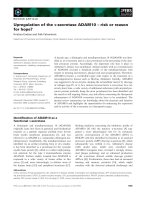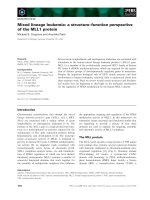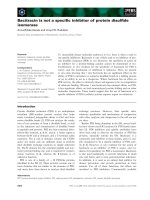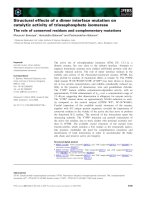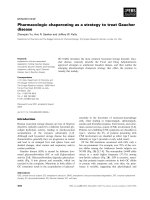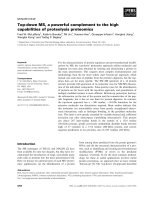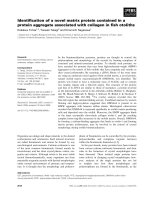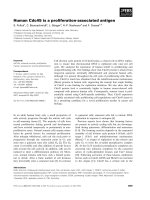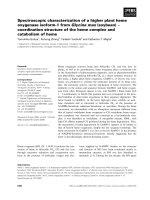Báo cáo khoa học: "Subcat-LMF: Fleshing out a standardized format for subcategorization frame interoperability" potx
Bạn đang xem bản rút gọn của tài liệu. Xem và tải ngay bản đầy đủ của tài liệu tại đây (147.39 KB, 11 trang )
Proceedings of the 13th Conference of the European Chapter of the Association for Computational Linguistics, pages 550–560,
Avignon, France, April 23 - 27 2012.
c
2012 Association for Computational Linguistics
Subcat-LMF: Fleshing out a standardized format
for subcategorization frame interoperability
Judith Eckle-Kohler
‡
and Iryna Gurevych
†‡
† Ubiquitous Knowledge Processing Lab (UKP-DIPF)
German Institute for Educational Research and Educational Information
‡ Ubiquitous Knowledge Processing Lab (UKP-TUDA)
Department of Computer Science
Technische Universit
¨
at Darmstadt
Abstract
This paper describes Subcat-LMF, an ISO-
LMF compliant lexicon representation for-
mat featuring a uniform representation
of subcategorization frames (SCFs) for
the two languages English and German.
Subcat-LMF is able to represent SCFs at a
very fine-grained level. We utilized Subcat-
LMF to standardize lexicons with large-
scale SCF information: the English Verb-
Net and two German lexicons, i.e., a subset
of IMSlex and GermaNet verbs. To evalu-
ate our LMF-model, we performed a cross-
lingual comparison of SCF coverage and
overlap for the standardized versions of the
English and German lexicons. The Subcat-
LMF DTD, the conversion tools and the
standardized versions of VerbNet and IMS-
lex subset are publicly available.
1
1 Introduction
Computational lexicons providing accurate
lexical-syntactic information, such as subcatego-
rization frames (SCFs) are vital for many NLP
applications involving parsing and word sense
disambiguation. In parsing, SCFs have been
successfully used to improve the output of sta-
tistical parsers (Klenner (2007), Deoskar (2008),
Sigogne et al. (2011)) which is particularly
significant in high-precision domain-independent
parsing. In word sense disambiguation, SCFs
have been identified as important features for
verb sense disambiguation (Brown et al., 2011),
which is due to the correlation of verb senses and
SCFs (Andrew et al., 2004).
SCFs specify syntactic arguments of verbs and
other predicate-like lexemes, e.g. the verb say
1
/>takes two arguments that can be realized, for in-
stance, as noun phrase and that-clause as in He
says that the window is open.
Although a number of freely available, large-
scale and accurate SCF lexicons exist, e.g. COM-
LEX (Grishman et al., 1994), VerbNet (Kipper
et al., 2008) for English, availability and limita-
tions in size and coverage remain an inherent is-
sue. This applies even more to languages other
than English.
One particular approach to address this issue is
the combination and integration of existing man-
ually built SCF lexicons. Lexicon integration
has widely been adopted for increasing the cover-
age of lexicons regarding lexical-semantic infor-
mation types, such as semantic roles, selectional
restrictions, and word senses (e.g., Shi and Mi-
halcea (2005), the Semlink project
2
, Navigli and
Ponzetto (2010), Niemann and Gurevych (2011),
Meyer and Gurevych (2011)).
Currently, SCFs are represented idiosyncrati-
cally in existing SCF lexicons. However, inte-
gration of SCFs requires a common, interopera-
ble representation format. Monolingual SCF in-
tegration based on a common representation for-
mat has already been addressed by King and
Crouch (2005) and just recently by Necsulescu et
al. (2011) and Padr
´
o et al. (2011). However, nei-
ther King and Crouch (2005) nor Necsulescu et
al. (2011) or Padr
´
o et al. (2011) make use of ex-
isting standards in order to create a uniform SCF
representation for lexicon merging. The defini-
tion of an interoperable representation format ac-
cording to an existing standard, such as the ISO
standard Lexical Markup Framework (LMF, ISO
24613:2008, see Francopoulo et al. (2006)), is the
2
/>550
prerequisite for re-using this format in different
contexts, thus contributing to the standardization
and interoperability of language resources.
While LMF models exist that cover the rep-
resentation of SCFs (see Quochi et al. (2008),
Buitelaar et al. (2009)), their suitability for repre-
senting SCFs at a large scale remains unclear: nei-
ther of these LMF-models has been used for stan-
dardizing lexicons with a large number of SCFs,
such as VerbNet. Furthermore, the question of
their applicability to different languages has not
been investigated yet, a situation that is compli-
cated by the fact that SCFs are highly language-
specific.
The goal of this paper is to address these gaps
for the two languages English and German by pre-
senting a uniform LMF representation of SCFs
for English and German which is utilized for the
standardization of large-scale English and Ger-
man SCF lexicons. The contributions of this
paper are threefold: (1) We present the LMF
model Subcat-LMF, an LMF-compliant lexicon
representation format featuring a uniform and
very fine-grained representation of SCFs for En-
glish and German. Subcat-LMF is a subset of
Uby-LMF (Eckle-Kohler et al., 2012), the LMF
model of the large integrated lexical resource Uby
(Gurevych et al., 2012). (2) We convert lexicons
with large-scale SCF information to Subcat-LMF:
the English VerbNet and two German lexicons,
i.e., GermaNet (Kunze and Lemnitzer, 2002) and
a subset of IMSlex
3
(Eckle-Kohler, 1999). (3) We
perform a comparison of these three lexicons re-
garding SCF coverage and SCF overlap, based on
the standardized representation.
The remainder of this paper is structured as fol-
lows: Section 2 gives a detailed description of
Subcat-LMF and section 3 demonstrates its use-
fulness for representing and cross-lingually com-
paring large-scale English and German lexicons.
Section 4 provides a discussion including related
work and section 5 concludes.
2 Subcat-LMF
2.1 ISO-LMF: a meta-model
LMF defines a meta-model of lexical resources,
covering NLP lexicons and Machine Readable
Dictionaries. This meta-model is based on the
Unified Modeling Language (UML) and speci-
3
/>fies a core package and a number of extensions
for modeling different types of lexicons, includ-
ing subcategorization lexicons.
The development of an LMF-compliant lexi-
con model requires two steps: in the first step,
the structure of the lexicon model has to be de-
fined by choosing a combination of the LMF core
package and zero to many extensions (i.e. UML
packages). While the LMF core package models
a lexicon in terms of lexical entries, each of which
is defined as the pairing of one to many forms and
zero to many senses, the LMF extensions provide
UML classes for different types of lexicon orga-
nization, e.g., covering the synset-based organiza-
tion of WordNet and the class-based organization
of VerbNet. The first step results in a set of UML
classes that are associated according to the UML
diagrams given in ISO LMF.
In the second step, these UML classes may be
enriched by attributes. While neither attributes
nor their values are given by the standard, the
standard states that both are to be linked to Data
Categories (DCs) defined in a Data Category Reg-
istry (DCR) such as ISOCat.
4
DCs that are not
available in ISOCat may be defined and submit-
ted for standardization. The second step results in
a so-called Data Category Selection (DCS).
DCs specify the linguistic vocabulary used in
an LMF model. Consider as an example the
linguistic term direct object that often occurs in
SCFs of verbs taking an accusative NP as argu-
ment. In ISOCat, there are two different specifi-
cations of this term, one explicitly referring to the
capability of becoming the clause subject in pas-
sivization
5
, the other not mentioning passivization
at all.
6
Consequently, the use of a DCR plays a
major role regarding the semantic interoperability
of lexicons (Ide and Pustejovsky, 2010). Different
resources that share a common definition of their
linguistic vocabulary are said to be semantically
interoperable.
2.2 Fleshing out ISO-LMF
Approach: We started our development of
Subcat-LMF with a thorough inspection of large-
scale English and German resources providing
SCFs for verbs, nouns, and adjectives. For
4
the implementation of the ISO
12620 DCR (Broeder et al., 2010).
5
/>6
/>551
English, our analysis included VerbNet
7
and
FrameNet syntactically annotated example sen-
tences from Ruppenhofer et al. (2010). For Ger-
man, we inspected GermaNet, SALSA annota-
tion guidelines (Burchardt et al., 2006) and IM-
Slex documentation (Eckle-Kohler, 1999). In ad-
dition, the EAGLES synopsis on morphosyntactic
phenomena
8
(Calzolari and Monachini, 1996), as
well as the EAGLES recommendations on subcat-
egorization
9
have been used to identify DCs rele-
vant for SCFs.
We specified Subcat-LMF by a DTD yielding
an XML serialization of ISO-LMF. Thus, existing
lexicons can be standardized, i.e. converted into
Subcat-LMF format, based on the DTD.
10
Lexicon structure: Next, we defined the
lexicon structure of Subcat-LMF. In addition
to the core package, Subcat-LMF primarily
makes use of the LMF Syntax and Seman-
tics extension. Figure 1 shows the most
important classes of Subcat-LMF including
SynsemCorrespondence where the linking of
syntactic and semantic arguments is encoded. It
might by worth noting that both synsets from Ger-
maNet and verb classes from VerbNet can be rep-
resented in Subcat-LMF by using the Synset and
SubcategorizationFrameSet class.
Diverging linguistic properties of SCFs in
English and German: For verbs (and also for
predicate-like nouns and adjectives), SCFs spec-
ify the syntactic and morphosyntactic properties
of their arguments that have to be present in con-
crete realizations of these arguments within a sen-
tence. While some properties of syntactic argu-
ments in English and German correspond (both
English and German are Germanic languages and
hence closely related), there are other properties,
mainly morphosyntactic ones that diverge. By
way of examples, we illustrate some of these di-
vergences in the following (we contrast English
examples with their German equivalents):
• overt case marking in German:
He helps him. vs. Er hilft ihm. (dative)
• specific verb form in verb phrase arguments:
He suggested cleaning the house. (ing-form)
7
SCFs in VerbNet also cover SCFs in VALEX, a lexicon
automatically extracted from corpora.
8
/>9
/>10
Available at />vs.
Er schlug vor, das Haus zu putzen. (to-
infinitive)
• morphosyntactic marking of verb phrase ar-
guments in the main clause: He managed to
win. (no marking) vs.
Er hat es geschafft zu gewinnen. (obligatory
es)
• morphosyntactic marking of clausal argu-
ments in the main clause: That depends on
who did it. (preposition) vs.
Das h
¨
angt davon ab, wer es getan hat.
(pronominal adverb)
Uniform Data Categories for English and Ger-
man: Thus, the main challenge in developing
Subcat-LMF has been the specification of DCs
(attributes and attribute values) in such a way,
that a uniform specification of SCFs in the two
languages English and German can be achieved.
The specification of DCs for Subcat-LMF in-
volved fleshing out ISO-LMF, because it is a
meta-standard in the sense that it provides only
few linguistic terms, i.e. DCs, and these DCs
are not linked to any DCR: in the Syntax Exten-
sion, the standard only provides 7 class names,
see Figure 1), complemented by 17 example at-
tributes given in an informative, non-binding An-
nex F. These are by far not sufficient to repre-
sent the fine-grained SCFs available in such large-
scale lexicons as VerbNet.
In contrast, the Syntax part of Subcat-LMF
comprises 58 DCs that are properly linked to
ISOCat DCs; a number of DCs were missing in
ISOCat, so we entered them ourselves.
11
The
majority of the attributes in Subcat-LMF are at-
tached to the SyntacticArgument class. The
corresponding DCs can be divided into two main
groups:
Cross-lingually valid DCs for the spec-
ification of grammatical functions (e.g.
subject, prepositionalComplement)
and syntactic categories (e.g. nounPhrase,
prepositionalPhrase), see Table 1.
Partly language-specific morphosyntactic
DCs that further specify the syntactic arguments
(e.g. attribute case, attribute verbForm and
11
The Subcat-LMF DCS is publicly available on the ISO-
Cat website.
552
Figure 1: Selected classes of Subcat-LMF.
Values of grammaticalFunction Example
subject They arrived in time.
subjectComplement He becomes a teacher.
directObject He saw a rainbow.
objectComplement They elected him governor.
complement He told him a story.
prepositionalComplement It depends on several factors.
adverbialComplement They moved far away.
Values of syntacticCategory Example
nounPhrase The train stopped.
reflexive He drank himself sick.
expletive It is raining.
prepositionalPhrase It depends on several factors.
adverbPhrase They moved far away.
adjectivePhrase The light turned red.
verbPhrase She tried to exercise.
declarativeClause He says he agrees.
subordinateClause He believes that it works.
Table 1: Cross-lingually valid (English-German) attributes and values of the SyntacticArgument class.
values toInfinitive, bareInfinitive,
ingForm, participle), see Table 2.
In the class LexemeProperty, we introduced
an attribute syntacticProperty to encode
control and raising properties of verbs taking in-
finitival verb phrase arguments.
12
In Subcat-LMF, syntactic arguments can be
specified by a selection of appropriate attribute-
value pairs. While all syntactic arguments are uni-
formly specified by a grammatical function and a
syntactic category, the use of the morphosyntactic
attributes depends on the particular type of syn-
tactic argument. Different phrase types are spec-
12
Control or raising specify the co-reference between the
implicit subject of the infinitival argument and syntactic ar-
guments in the main clause, either the subject (subject con-
trol or raising) or direct object (object control or raising).
ified by different subsets of morphosyntactic at-
tributes, see Table 2. The following examples il-
lustrate some of these attributes:
• number: the number of a noun phrase argu-
ment can be lexically governed by the verb
as in These types of fish mix well together.
• verbForm: the verb form of a clausal com-
plement can be required to be a bare infini-
tive as in They demanded that he be there.
• tense: not only the verb form, but also the
tense of a verb phrase complement can be
lexically governed, e.g., to be a participle in
the past tense as in They had it removed.
553
Morphosyntactic attributes and values NP PP VP C
case: nominative, genitive, dative, accusative x x
determiner: possessive, indefinite x x
number: singular, plural x
verbForm: toInfinitive, bareInfinitive, ingForm(!), Participle x x
tense: present, past x
complementizer: thatType, whType, yesNoType x
prepositionType: external ontological type, e.g. locative x x x
preposition: (string) (!) x x x
lexeme: (string) (!) x x
Table 2: Morphosyntactic attributes of SyntacticArgument and phrase types for which the attributes are
appropriate (NP: noun phrase, PP: prepositional phrase, VP: verb phrase, C: clause). Language-specific attributes
are marked by (!).
3 Utilizing Subcat-LMF
3.1 Standardizing large-scale lexicons
Lexicon Data: We converted VerbNet (VN) and
two German lexicons, i.e., GermaNet (GN) and
a subset of IMSlex (ILS) to Subcat-LMF format.
ILS has been developed independently from GN
and the lexicon data were published in Eckle-
Kohler (1999).
VN is organized in verb classes based on Levin-
style syntactic alternations (Levin, 1993): verbs
with common SCFs and syntactic alternation be-
havior that also share common semantic roles are
grouped into classes. VN (version 3.1) lists 568
frames that are encoded as phrase structure rules
(XML element SYNTAX), specifying phrase types
and semantic roles of the arguments, as well as se-
lectional, syntactic and morphosyntactic restric-
tions on the arguments. Additionally, a descrip-
tive specification of each frame is given (XML
element DESCRIPTION). The verb learn, for in-
stance, has the following VN frame:
DESCRIPTION (primary): NP V NP
SYNTAX: Agent V Topic
We extracted both the descriptive specifications
and the phrase structure rules, using the API
available for VN
13
, resulting in 682 unique VN
frames.
14
GN provides detailed SCFs for verbs, in
contrast to the Princeton WordNet: GN version
6.0 from April 2011 accessed by the GN API
15
lists 202 frames. GN SCFs are represented as a
13
/>14
The VN API was used with the view options wrexyzsq
for verb frame pairs and ctuqw for verb class information.
15
GermaNet Java API 2.0.2
dot-separated sequence of letter pairs. Each letter
pair specifies a syntactic argument: the first letter
encodes the grammatical function and the second
letter the syntactic category.
16
For instance, the
following shows the GN code for transitive verbs:
NN.AN.
ILS is represented in delimiter-separated
values format and contains 784 verbs in total.
Of these 784 verbs, 740 of them are also present
in GN, and 44 are listed in ILS only. Although
ILS contains only verbs that take clausal ar-
guments and verb phrase arguments, a total
number of 220 SCFs is present in ILS, also
including SCFs without clausal and verb phrase
arguments. ILS lists for each verb lemma a
number of SCFs, thus specifying coarse-grained
verb senses given by a lemma-SCF pair.
17
The
SCFs are represented as parenthesized lists. For
instance, the ILS SCF for transitive verbs is:
(subj(NPnom),obj(NPacc)).
Automatic Conversion: We implemented Java
tools for the conversion of VN, GN and ILS to
Subcat-LMF. These tools convert the source lexi-
cons based on a manual mapping of lexicon units
and terms (e.g., VN verb class, GN synset) to
Subcat-LMF. For the majority of SCFs, this map-
ping is defined on argument level. Lexical data
is extracted from the source lexicons by using the
native APIs (VN, GN) and additional Perl scripts.
16
See />verb frames.shtml
17
In addition, ILS provides a semantic class label for each
verb; however, these semantic labels are attached at lemma
level, i.e. they need to be disambiguated.
554
# LexicalEntry # Sense # Subcat.Frame # SemanticPred.
LMF-VN 3962 31891 284 617
orig. VN (3962 verbs) (31891 groups of verb,
frame, sem.pred.)
(568 frames) (572 sem. Pred.)
LMF-GN 8626 12981 147 84
orig. GN (8626 verbs) (12981 verb-synset pairs) (202 GN frames) (no sem. Pred.)
LMF-ILS 784 3675 217 10
orig. ILS (784 verbs) (3675 verb-frame pairs) (220 SCFs) (no sem. Pred.)
Table 3: Evaluation of the automatic conversion. Numbers of Subcat-LMF instances in the converted lexicons
compared to numbers of corresponding units in original lexicons.
Evaluation of Automatic Conversion: Table 3
shows the mapping of the major source lexicon
units (such as verb-synset pairs) to Subcat-LMF
and lists the corresponding numbers of units.
For VN, groups of VN verb, frame and se-
mantic predicate have been mapped to LMF
senses. VN classes have been mapped to
SubcategorizationFrameSet. Thus, the
original VN-sense, a pairing of verb lemma and
class, can be recovered by grouping LMF senses
that share the same verb class. There is a signif-
icant difference between the original VN frames
and their Subcat-LMF representation: the seman-
tic information present in VN frames (seman-
tic roles and selectional restrictions) is mapped
to semantic arguments in Subcat-LMF, i.e. the
mapping splits VN frames into a purely syntac-
tic and a purely semantic part. Consequently,
the number of unique SCFs in the Subcat-LMF
version of VN is much smaller than the num-
ber of frames in the original VN. The conversion
tool creates for each sense (specifying a unique
verb, frame, semantic predicate combination) a
SynSemCorrespondence.
On the other hand, the Subcat-LMF version of VN
contains more semantic predicates than VN. This
is due to selectional restrictions for semantic ar-
guments that are specified in Subcat-LMF within
semantic predicates, in contrast to VN.
For GN, verb-synset pairs (i.e., GN lexical
units), have been mapped to LMF senses. Few
GN frame codes also specify semantic role in-
formation, e.g. manner, location. These were
mapped to the semantics part of Subcat-LMF re-
sulting in 84 semantic predicates that encode the
semantic role information in their semantic argu-
ments.
ILS specifies similar semantic role information
as GN; these few cases were mapped in the same
way as for GN. Therefore, the LMF version of
ILS, too, specifies less SCFs, but additional se-
mantic predicates not present in the original.
Discussion: Grammatical functions of argu-
ments are specified distinctly in the three lexicons.
While both GN and ILS specify grammatical
functions, they are not explicitly encoded in VN.
They have to be inferred on the basis of the phrase
structure rules given in the SYNTAX element. We
assigned subject to the noun phrase which di-
rectly precedes the verb and directObject to
the noun phrase directly following the verb and
having the semantic role Patient. The semantic
role information has to be considered at this point,
because not all noun phrase arguments are able
to become the subject in a corresponding passive
sentence. An example is the verb learn which
has the VN frame NP(Agent) V NP(Topic);
here, the Topic-NP is not able to become the sub-
ject of a corresponding passive sentence. We as-
signed the grammatical function complement to
all other phrase types.
Argument order constraints in SCFs are repre-
sented in LMF by a list implementation of syntac-
tic arguments. Most SCFs from VN require the
subject to be the first argument, reflecting the ba-
sic word order in English sentences. VN lists one
exception to this rule for the verb appear, illus-
trated by the example On the horizon appears a
ship.
Argument optionality in VN is expressed at the
semantic level and at the syntactic level in paral-
lel: it is explicitly specified at the semantic level
and implicitly specified at the syntactic level. At
the syntactic level, two SCF versions exist in VN,
one with the optional argument, the other without
it. In addition, the semantic predicate attached to
555
these SCFs marks optional (semantic) arguments
by a ?-sign. GN, on the other hand, expresses
argument optionality at the level of syntactic ar-
guments, i.e., within the frame code. In Subcat-
LMF, optionality is represented at the syntactic
level by an (optional) attribute optional for syn-
tactic arguments, thus reflecting the explicit repre-
sentation used in GN and the implicit representa-
tion present in VN.
18
GN frames specify syntactic alternations of ar-
gument realizations, e.g. adverbial complements
that can alternatively be realized as adverb phrase,
prepositional phrase or noun phrase. We encoded
this generalization in Subcat-LMF by introducing
attribute values for these aggregated syntactic cat-
egories.
3.2 Cross-lingual comparison of lexicons
Lexicons that are standardized according to
Subcat-LMF can be quantitatively compared re-
garding SCFs. For two lexicons, such a com-
parison gives answers to questions, such as: how
many SCFs are present in both lexicons (overlap-
ping SCFs), how many SCFs are only listed in one
of the lexicons (complementary SCFs). Answers
to these questions are important, for instance, for
assessing the potential gain in SCF coverage that
can be achieved by lexicon merging.
In order to validate our claim that Subcat-LMF
yields a cross-lingually uniform SCF represen-
tation, we contrast the monolingual comparison
of GN and ILS with the cross-lingual compari-
son of VN, GN and VN and ILS. Assuming that
our claim is valid, the cross-lingual comparisons
can be expected to yield similar results regard-
ing overlapping and complementary SCFs as the
monolingual comparison.
Comparison: The comparison of SCFs from
two lexicons that are in Subcat-LMF format can
be performed on the basis of the uniform DCs.
As Subcat-LMF is implemented in XML, we
compared string representations of SCFs. SCFs
from VN, GN and ILS were converted to strings
by concatenating attribute values of syntactic ar-
guments and lexemeProperty. We created
string representations of different granularities:
First, fine-grained, language-specific string SCFs
have been generated by concatenating all at-
18
As a consequence, all semantic arguments specified in
the Subcat-LMF version of VN have a corresponding syn-
tactic argument.
tribute values apart from the attribute optional
which is specific to GN (resulting in a consid-
erably smaller number of SCFs in GN). Sec-
ond, fine-grained, but cross-lingual string SCFs
were considered; these omit the attributes case,
lexeme, preposition and the attribute value
ingForm. Finally, coarse-grained cross-lingual
string SCFs were compared. These only con-
tain the values of the attributes syntactic
category, complementizer and verbForm
(without the attribute value ingForm). For in-
stance, a coarse cross-lingual string SCF for tran-
sitive verbs is nounPhrasenounPhrase.
Table 4 lists the results of our quantitative com-
parison. For each lexicon pair, the number of
overlapping SCFs and the numbers of comple-
mentary SCFs are given. Regarding VN and the
German lexicons, the overlap at the language-
specific level is (close to) zero, which is due to the
specification of case, e.g. dative, for German ar-
guments. However, the numbers for cross-lingual
SCFs clearly validate our claim: the numbers of
overlapping SCFs for the German lexicon pair and
for the two German-English pairs are comparable,
ranging from 12 to 18 for the fine-grained SCFs
and from 20 to 21 for the coarse SCFs.
Based on the sets of cross-lingually overlap-
ping SCFs, we made an estimation on how many
high frequent verbs actually have SCFs that are
in the cross-lingual SCF overlap of an English-
German lexicon pair. For this, we used the lemma
frequency lists of the English and German WaCky
corpora (Baroni et al., 2009) and extracted verbs
from VN, GN and ILS that are on 100 top ranked
positions of these lists, starting from rank 100.
19
Table 5 shows the results for the cross-lingual
SCF overlap between VN – GN and between VN
– ILS. While only around 40% of the high fre-
quent verbs have an SCF in the fine-grained SCF
overlap, more than 70% are in the coarse overlap
between VN – GN, and even more than 80% in
the coarse overlap between VN – ILS.
Analysis of results: The small numbers of
overlapping cross-lingual SCFs (relative to the to-
tal number of SCFs), at both levels of granularity,
indicate that the three lexicons each encode sub-
stantially different lexical-syntactic properties of
19
Since the WaCky frequency lists do not contain POS in-
formation, our lists of extracted verbs contain some noise,
which we tolerated, because we aimed at an approximate es-
timate.
556
language-specific cross-lingual cross-lingual
(fine-grained) (fine-grained) (coarse)
GN vs. ILS 72 GN 21 both, 196 ILS 61 GN, 23 both, 69 ILS 40 GN, 24 both, 23 ILS
VN vs. GN 284 VN, 0 both, 93 GN 96 VN, 15 both, 69 GN 29 VN, 24 both, 40 GN
VN vs. ILS 283 VN, 1 both, 216 ILS 93 VN, 18 both, 74 ILS 31 VN, 22 both, 25 ILS
Table 4: Comparison of lexicon pairs regarding SCF overlap and complementary SCFs.
VN-GN overlap VN-GN overlap VN-ILS overlap VN-ILS overlap
fine-grained (15 SCFs) coarse (24 SCFs) fine-grained (18 SCFs) coarse (22 SCFs)
43% VN verbs 85% VN verbs 41% VN verbs 84% VN verbs
41% GN verbs 71% GN verbs 43% ILS verbs 87% ILS verbs
Table 5: Percentage of 100 high frequent verbs from VN, GN, ILS with a SCF in the cross-lingual SCF overlap
(fine-grained vs. coarse) between VN – GN and VN – ILS.
verbs. This can at least partly be explained by the
historic development of these lexicons in differ-
ent contexts, e.g., Levin’s work on verb classes
(VN), Lexical Functional Grammar (ILS), as well
as their use for different purposes and applica-
tions.
Another reason of the small SCF overlap is
the comparison of strings derived from the XML
format. A more sophisticated representation for-
mat, notably one that provides semantic typing
and type hierarchies, e.g., OWL, could be em-
ployed to define hierarchies of grammatical func-
tions (e.g. direct object would be a sub-type of
complement) and other attributes. These would
presumably support the identification of further
overlapping SCFs.
During a subsequent qualitative analysis of the
overlapping and complementary SCFs, we col-
lected some enlightening background informa-
tion. Overlapping SCFs in the cross-lingual com-
parison (both fine-grained and coarse) include
prominent SCFs corresponding to transitive and
intransitive verbs, as well as verbs with that-
clause and verbs with to-infinitive.
GN and ILS are highly complementary regard-
ing SCFs: for instance, while many SCFs with ad-
verbial arguments are unique in GN, only ILS pro-
vides a fine-grained specification of prepositional
complements including the preposition, as well
as the case the preposition requires.
20
VN, too,
contains a large number of SCFs with a detailed
specification of possible prepositions, partly spec-
20
In German, prepositions govern the case of their noun
phrase.
ified as language-independent preposition types.
A large number of complementary SCFs in VN
vs. GN and GN vs. ILS are due to a diverging lin-
guistic analysis of extraposed subject clauses with
an es (it) in the main clause (e.g., It annoys him
that the train is late.). In GN, such clauses are not
specified as subject, whereas in VN and ILS they
are.
Regarding VN and ILS, only VN lists subject
control for verbs, while both VN and ILS list ob-
ject control and subject raising. GN, on the other
hand, does not specify control or raising at all.
4 Discussion
4.1 Previous Work
Merging SCFs: Previous work on merging SCF
lexicons has only been performed in a mono-
lingual setting and lacks the use of standards.
King and Crouch (2005) describe the process of
unifying several large-scale verb lexicons for En-
glish, including VN and WordNet. They perform
a conversion of these lexicons into a uniform, but
non-standard representation format, resulting in a
lexicon which is integrated at the level of verb
senses, SCFs and lexical-semantics. Thus, the re-
sult of their work is not applicable to cross-lingual
settings.
Necsulescu et al. (2011) and Padr
´
o et al. (2011)
report on approaches to automatic merging of
two Spanish SCF lexicons. As these lexicons
lack sense information apart from the SCFs, their
merging approach only works on a very coarse-
grained sense level given by lemma-SCF pairs.
The fully automatic merging approach described
557
in (Padr
´
o et al., 2011) assumes that one of the lex-
icons to be integrated is already represented in the
target representation format, i.e. given two lexi-
cons, they map one lexicon to the format of the
other. Moreover, their approach requires a signif-
icant overlap of SCFs and verbs in any two lex-
icons to be merged. The authors state that it is
presently unclear, how much overlap is required
to obtain sufficiently precise merging results.
Standardizing SCFs: Much previous work on
standardizing NLP lexicons in LMF has focused
on WordNet-like resources. Soria et al. (2009) de-
scribe WordNet-LMF, an LMF model for repre-
senting wordnets which has been used in the KY-
OTO project.
21
Later, WordNet-LMF has been
adapted by Henrich and Hinrichs (2010) to Ger-
maNet and by Toral et al. (2010) to the Ital-
ian WordNet. WordNet-LMF does not provide
the possibility to represent subcategorization at
all. The adaption of WordNet-LMF to GN (Hen-
rich and Hinrichs, 2010) allows SCFs to be re-
spresented as string values. However, this ex-
tension is not sufficient, because it provides no
means to model the syntax-semantics interface,
which specifies correspondences between syntac-
tic and semantic arguments of verbs and other
predicates. Quochi et al. (2008) report on an LMF
model that covers the syntax-semantics mapping
just mentioned; it has been used for standardizing
an Italian domain-specific lexicon. Buitelaar et al.
(2009) describe LexInfo, an LMF-model that is
used for lexicalizing ontologies. LexInfo is imple-
mented in OWL and specifies a linking of syntac-
tic and semantic arguments. For SCFs and argu-
ments, a type hierarchy is defined. In their paper,
Buitelaar et al. (2009) show only few SCFs and
do not indicate what kinds of SCFs can be repre-
sented with LexInfo in principle. On the LexInfo
website
22
, the current LexInfo version 2.0 can be
viewed, but no further documentation is given.
We inspected LexInfo version 2.0 and found that
it specifies a large number of fine-grained SCFs.
However, LexInfo has not been evaluated so far
on large-scale SCF lexicons, such as VerbNet.
4.2 Subcat-LMF
Subcat-LMF enables the uniform representation
of fine-grained SCFs across the two languages
English and German. By mapping large-scale
21
/>22
See />SCF lexicons to Subcat-LMF, we have demon-
strated its usability for uniformly representing a
wide range of SCFs and other lexical-syntactic in-
formation types in English and German.
As our cross-lingual comparison of lexicons
has revealed many complementary SCFs in VN,
GN and ILS, mono- and cross-lingual alignments
of these lexicons at sense level would lead to a
major increase in SCF coverage. Moreover, the
cross-lingually uniform representation of SCFs
can be exploited for an additional alignment of
the lexicons at the level of SCF arguments. Such
a fine-grained alignment of SCFs can be used, for
instance, to project VN semantic roles to GN, thus
yielding a German resource for semantic role la-
beling (see Gildea and Jurafsky (2002), Swier and
Stevenson (2005)).
Subcat-LMF could be used for standardizing
further English and German lexicons. The auto-
matic conversion of lexicons to Subcat-LMF re-
quires the manual definition of a mapping, at least
for syntactic arguments. Furthermore, the auto-
matic merging approach by Padr
´
o et al. (2011)
could be tested for English: given our standard-
ized version of VN, other English SCF lexicons
could be merged fully automatically with the
Subcat-LMF version of VN.
5 Conclusion
Subcat-LMF contributes to fostering the standard-
ization of language resources and their interop-
erability at the lexical-syntactic level across En-
glish and German. The Subcat-LMF DTD in-
cluding links to ISOCat, all conversion tools,
and the standardized versions of VN and
ILS
23
are publicly available at -
darmstadt.de/data/uby.
Acknowledgments
This work has been supported by the Volks-
wagen Foundation as part of the Lichtenberg-
Professorship Program under grant No. I/82806.
We thank the anonymous reviewers for their valu-
able comments. We also thank Dr. Jungi Kim
and Christian M. Meyer for their contributions to
this paper, and Yevgen Chebotar and Zijad Mak-
suti for their contributions to the conversion soft-
ware.
23
The converted version of GN can not be made available
due to licensing.
558
References
Galen Andrew, Trond Grenager, and Christopher D.
Manning. 2004. Verb sense and subcategoriza-
tion: using joint inference to improve performance
on complementary tasks. In Proceedings of the
2004 Conference on Empirical Methods in Natural
Language Processing (EMNLP), pages 150–157,
Barcelona, Spain.
Marco Baroni, Silvia Bernardini, Adriano Ferraresi,
and Eros Zanchetta. 2009. The WaCky wide web:
a collection of very large linguistically processed
web-crawled corpora. Language Resources and
Evaluation, 43(3):209–226.
Daan Broeder, Marc Kemps-Snijders, Dieter Van Uyt-
vanck, Menzo Windhouwer, Peter Withers, Peter
Wittenburg, and Claus Zinn. 2010. A Data Cat-
egory Registry- and Component-based Metadata
Framework. In Proceedings of the Seventh Inter-
national Conference on Language Resources and
Evaluation (LREC), pages 43–47, Valletta, Malta.
Susan Windisch Brown, Dmitriy Dligach, and Martha
Palmer. 2011. VerbNet Class Assignment as a
WSD Task. In Proceedings of the 9th International
Conference on Computational Semantics (IWCS),
pages 85–94, Oxford, UK.
Paul Buitelaar, Philipp Cimiano, Peter Haase, and
Michael Sintek. 2009. Towards Linguistically
Grounded Ontologies. In Lora Aroyo, Paolo
Traverso, Fabio Ciravegna, Philipp Cimiano, Tom
Heath, Eero Hyv
¨
onen, Riichiro Mizoguchi, Eyal
Oren, Marta Sabou, and Elena Simperl, editors, The
Semantic Web: Research and Applications, pages
111–125, Berlin Heidelberg. Springer-Verlag.
Aljoscha Burchardt, Katrin Erk, Anette Frank, Andrea
Kowalski, Sebastian Pad
´
o, and Manfred Pinkal.
2006. The SALSA Corpus: a German Corpus Re-
source for Lexical Semantics. In Proceedings of
the Fifth International Conference on Language Re-
sources and Evaluation (LREC), pages 969–974,
Genoa, Italy.
Nicoletta Calzolari and Monica Monachini. 1996.
EAGLES Proposal for Morphosyntactic Stan-
dards: in view of a ready-to-use package. In
G. Perissinotto, editor, Research in Humanities
Computing, volume 5, pages 48–64. Oxford Uni-
versity Press, Oxford, UK.
Tejaswini Deoskar. 2008. Re-estimation of lexi-
cal parameters for treebank PCFGs. In Proceed-
ings of the 22nd International Conference on Com-
putational Linguistics (COLING), pages 193–200,
Manchester, United Kingdom.
Judith Eckle-Kohler, Iryna Gurevych, Silvana Hart-
mann, Michael Matuschek, and Christian M.
Meyer. 2012. UBY-LMF – A Uniform Format
for Standardizing Heterogeneous Lexical-Semantic
Resources in ISO-LMF. In Proceedings of the 8th
International Conference on Language Resources
and Evaluation (LREC 2012), page (to appear), Is-
tanbul, Turkey.
Judith Eckle-Kohler. 1999. Linguistisches Wissen zur
automatischen Lexikon-Akquisition aus deutschen
Textcorpora. Logos-Verlag, Berlin, Germany.
PhDThesis.
Gil Francopoulo, Nuria Bel, Monte George, Nico-
letta Calzolari, Monica Monachini, Mandy Pet, and
Claudia Soria. 2006. Lexical Markup Framework
(LMF). In Proceedings of the Fifth International
Conference on Language Resources and Evaluation
(LREC), pages 233–236, Genoa, Italy.
Daniel Gildea and Daniel Jurafsky. 2002. Automatic
labeling of semantic roles. Computational Linguis-
tics, 28:245–288, September.
Ralph Grishman, Catherine Macleod, and Adam Mey-
ers. 1994. Comlex Syntax: Building a Computa-
tional Lexicon. In Proceedings of the 15th Inter-
national Conference on Computational Linguistics
(COLING), pages 268–272, Kyoto, Japan.
Iryna Gurevych, Judith Eckle-Kohler, Silvana Hart-
mann, Michael Matuschek, Christian M. Meyer,
and Christian Wirth. 2012. Uby - A Large-Scale
Unified Lexical-Semantic Resource. In Proceed-
ings of the 13th Conference of the European Chap-
ter of the Association for Computational Linguistics
(EACL 2012), page (to appear), Avignon, France.
Verena Henrich and Erhard Hinrichs. 2010. Standard-
izing wordnets in the ISO standard LMF: Wordnet-
LMF for GermaNet. In Proceedings of the 23rd In-
ternational Conference on Computational Linguis-
tics (COLING), pages 456–464, Beijing, China.
Nancy Ide and James Pustejovsky. 2010. What Does
Interoperability Mean, anyway? Toward an Op-
erational Definition of Interoperability. In Pro-
ceedings of the Second International Conference
on Global Interoperability for Language Resources,
Hong Kong.
Tracy Holloway King and Dick Crouch. 2005. Uni-
fying lexical resources. In Proceedings of the In-
terdisciplinary Workshop on the Identification and
Representation of Verb Features and Verb Classes,
Saarbruecken, Germany.
Karin Kipper, Anna Korhonen, Neville Ryant, and
Martha Palmer. 2008. A Large-scale Classification
of English Verbs. Language Resources and Evalu-
ation, 42:21–40.
Manfred Klenner. 2007. Shallow dependency la-
beling. In Proceedings of the 45th Annual Meet-
ing of the Association for Computational Linguis-
tics (ACL), Companion Volume Proceedings of the
Demo and Poster Sessions, pages 201–204, Prague,
Czech Republic.
Claudia Kunze and Lothar Lemnitzer. 2002. Ger-
maNet — representation, visualization, applica-
tion. In Proceedings of the Third International
Conference on Language Resources and Evaluation
559
(LREC), pages 1485–1491, Las Palmas, Canary Is-
lands, Spain.
Beth Levin. 1993. English Verb Classes and Alterna-
tions. The University of Chicago Press, Chicago,
USA.
Christian M. Meyer and Iryna Gurevych. 2011. What
Psycholinguists Know About Chemistry: Align-
ing Wiktionary and WordNet for Increased Domain
Coverage. In Proceedings of the 5th International
Joint Conference on Natural Language Processing
(IJCNLP), pages 883–892, Chiang Mai, Thailand.
Roberto Navigli and Simone Paolo Ponzetto. 2010.
BabelNet: Building a very large multilingual se-
mantic network. In Proceedings of the 48th Annual
Meeting of the Association for Computational Lin-
guistics (ACL), pages 216–225, Uppsala, Sweden.
Silvia Necsulescu, N
´
uria Bel, Munsta Padr
´
o, Montser-
rat Marimon, and Eva Revilla. 2011. Towards
the Automatic Merging of Language Resources. In
Proceedings of the 2011 ESSLI Workshop on Lexi-
cal Resources (WoLeR 2011), Ljubljana, Slovenia.
Elisabeth Niemann and Iryna Gurevych. 2011. The
People’s Web meets Linguistic Knowledge: Auto-
matic Sense Alignment of Wikipedia and WordNet.
In Proceedings of the 9th International Conference
on Computational Semantics (IWCS), pages 205–
214, Oxford, UK.
Muntsa Padr
´
o, N
´
uria Bel, and Silvia Necsulescu.
2011. Towards the Automatic Merging of Lexical
Resources: Automatic Mapping. In Proceedings of
the International Conference on Recent Advances
in Natural Language Processing, pages 296–301,
Hissar, Bulgaria.
Valeria Quochi, Monica Monachini, Riccardo Del
Gratta, and Nicoletta Calzolari. 2008. A lexicon
for biology and bioinformatics: the bootstrep expe-
rience. In Proceedings of the Sixth International
Conference on Language Resources and Evalua-
tion (LREC’08), pages 2285–2292, Marrakech, Mo-
rocco, may.
Josef Ruppenhofer, Michael Ellsworth, Miriam R. L.
Petruck, Christopher R. Johnson, and Jan Schef-
fczyk. 2010. FrameNet II: Extended Theory and
Practice, September.
Lei Shi and Rada Mihalcea. 2005. Putting pieces to-
gether: Combining FrameNet, VerbNet and Word-
Net for robust semantic parsing. In Proceedings
of the Sixth International Conference on Intelligent
Text Processing and Computational Linguistics (CI-
CLing), pages 100–111, Mexico City, Mexico.
Anthony Sigogne, Matthieu Constant, and
´
Eric La-
porte. 2011. Integration of data from a syntac-
tic lexicon into generative and discriminative proba-
bilistic parsers. In Proceedings of the International
Conference on Recent Advances in Natural Lan-
guage Processing, pages 363–370, Hissar, Bulgaria.
Claudia Soria, Monica Monachini, and Piek Vossen.
2009. Wordnet-LMF: fleshing out a standardized
format for Wordnet interoperability. In Proceedings
of the 2009 International Workshop on Intercultural
Collaboration, pages 139–146, Palo Alto, Califor-
nia, USA.
Robert S. Swier and Suzanne Stevenson. 2005. Ex-
ploiting a verb lexicon in automatic semantic role
labelling. In Proceedings of the conference on Hu-
man Language Technology and Empirical Methods
in Natural Language Processing (HLT’05), pages
883–890, Vancouver, British Columbia, Canada.
Antonio Toral, Stefania Bracale, Monica Monachini,
and Claudia Soria. 2010. Rejuvenating the Italian
WordNet: upgrading, standarising, extending. In
Proceedings of the 5th Global WordNet Conference,
Bombay, India.
560
